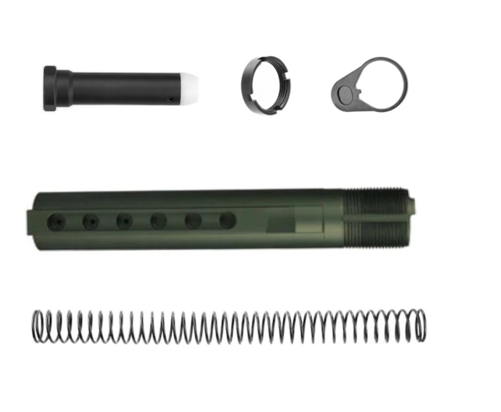Shooters that don’t like the way their rifles handle or fire are likely to swap out any number of components to improve the experience. That’s one of the beautiful things about a sporting rifle, they are so modular and can be modified easily.
If it’s not cycling quickly enough or the bolt is experiencing accelerated wear, switching to a BCG with greater permanent dry lubricity might affect either of these problems. If recoil is an issue, you can add a muzzle brake. The rifle’s too heavy forward? Swap out the Pic handguard for a lighter, more versatile M-LOK handguard.
But today the focus is the buffer tube - the overlooked component of handling and recoil management.
Before you start tricking out your rifle with some of the new parts listed above, turn your focus to the buffer tube system.
How a Buffer Tube Works
An AR’s buffer system consists of a tube that contains a spring and weights. It sits behind the bolt carrier group and serves as an attachment point for the stock; the stock actually attaches directly to the buffer tube assembly.
When you fire the weapon, the gasses captured by the rifle’s gas system, engage the BCG’s gas rings and cycle the bolt rearward. When the bolt carrier group moves to the rear, it contacts the buffer, which compresses the buffer spring. The BCG will travel rearward, partially into the buffer tube, until its kinetic energy is spent.
The buffer spring, which has stored this kinetic energy, then unloads it, pushing the bolt carrier group forward again, completing the cycling of the action.
The one component we haven’t mentioned yet is weight. In addition to a spring, the buffer tube contains a series of weights that help absorb recoil. The conservation of linear momentum dictates that the higher the buffer weights, the less felt recoil the shooter will experience, and this has significant impacts on the shooter’s experience - as much as the springs.
Since most gas tubes are fixed and adjustable gas blocks are rare, most of what is meant by “rifle tuning” has to do with adjustments to the buffer tube.
Heavier Buffer Tube Weights
Specifically for shooters that are recoil sensitive, adding a heavier buffer weight may be a good idea. This is because while the spring constitutes most of the resistance the BCG will encounter as it cycles to the rear, the mass of the buffer weights affects cycling, handling, and, you guessed it, felt recoil.
If the buffer system contained no weights, then the recoil would be distributed partially through the mass of the rifle and then partially into your shoulder. Without buffer weights, the recoil you experience would increase significantly.
The higher buffer weight can potentially improve cycling times (without making any adjustments to the buffer spring, that is) and it can also cut back on felt recoil. This can be beneficial in adjusting recoil in platforms where shooters are not comfortable adjusting the gas system. It can also serve as a potentially more economical alternative to buying and installing a muzzle brake.
Adding a beavier buffer tube weight has other advantages on top of diminished felt recoil, as well. While it does make the rifle heavier, it will push the center of mass to the rear and closer to the shooter’s body. For rifles with heavier handguards (such as Pic rail handguards) this can improve balance, making the rifle seem less front-heavy.
Adjusting the center of mass rearward can also improve the rifle’s feeling of responsiveness. The farther back the rifle appears to balance, the more muzzle-light it can be, improving handling and making it feel quicker and more maneuverable.
However, higher buffer weights can also potentially interfere with cycling. You should not add weight if the continued additions prevent the BCG from locking at the rear upon encountering an empty magazine. To check this, load and fire shots one at a time to ensure that the BCG locks at the rear after firing.
Lighter Buffer Tube Weights
It is also possible that you can potentially improve the shooting experience by lightening the buffer tube weight.
For example, if your rifle is taking too long to cycle or the ejected cartridges are flying too far forward out of the ejection port, it may be a sign that you need to lighten your buffer weight.
While heavier buffer weights typically correspond to quicker smoother cycling, if your rifle is experiencing any other cycling issues not mentioned here the culprit may be a buffer weight that is too heavy, especially if you have altered it.

The Parts You Need for at-Home Rifle Tuning
If you’re thinking about swapping out your buffer tube, spring or weights, we have everything you need to make precise adjustments to rifle tuning at home. Take a look through our collection of buffer tube systems and other AR-15 parts, including mil-spec components and tools and get in touch with us at 239-848-6757.

